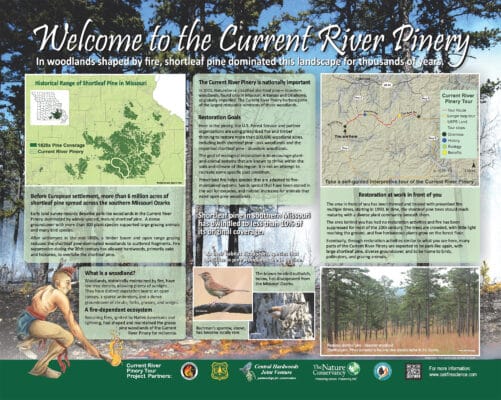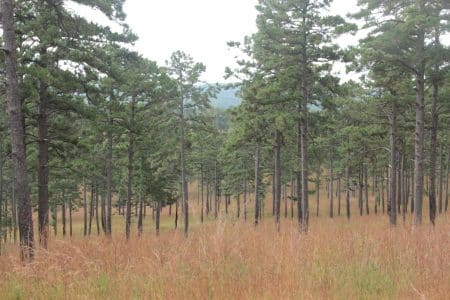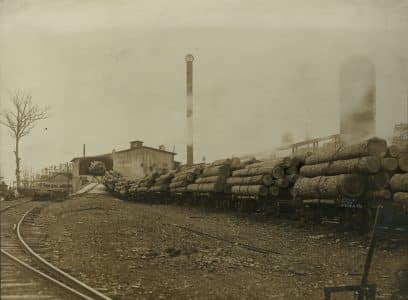You can enter the Current River Pinery self-guided tour in Carter County, Missouri, from either the west (via HWY J) or the east (via HWY C). At either end, you will find an ‘Overview’ stop, where you will encounter tall, spread-out pines dominating the site.
If you can’t be there in person, put yourself on-site in your mind by scrolling through the photos below as you listen. And, enlarge the sign to read it, as if you were there.
Hwy. J sign location, latitude/longitude: 36.89, -91.19
Hwy. C sign location, latitude/longitude: 36.90, -91.06
Not far from Stop 1 on our tour, smoke wafts among shortleaf pine trees against a blue sky in the midst of a prescribed fire in the Current River Pinery.
During prescribed burns, a torch mounted on a utility vehicle drips liquid fire to burn the perimeter. This one was traveling along Hwy J in Carter County, Mo., creating a line of fire that crawled into the woods. (Time code 0:06 – 0:25)
Burn Boss Tim Perren travels the perimeter of the burn unit throughout the day, checking with workers to assure a safe and trouble-free burn. (Time code 1:33 – 1:45)
The Current River Pinery spans about 100,000 acres in four Missouri counties, with the Current River to the east and the Eleven Point River to the southwest. (Time code 1:45-2:00)
The fire moves through a mix of pine, oaks, and hickories, big and small. Larger pines are adapted to fire, but smaller hardwoods will suffer fire damage, giving the pines a competitive advantage. (Time code 2:00 – 2:15)
This restored pine-bluestem woodland in Arkansas is part of a rare ecosystem that is found only in Missouri, Arkansas, and Okahoma, considered to be globally imperiled. The Current River Pinery harbors some of the largest restorable remnants of these woodlands. Photo: Michael Stambaugh (Time code 2:33-2:53)
Driving along Bennett Road in the pinery, you’ll see scenes that exemplify woodlands, which are historically maintained by fire. They have a low density of trees, allowing plenty of sunlight, and they have distinct layers: an open canopy, a sparse understory, and dense groundcover. (Time code 2:53-3:08)
Early settlers in this area found open forests with large shortleaf pine and hardwood trees, with rich ground flora. Pre-settlement woodlands had been shaped by periodic fire. Hundreds of plant species supported elk, bison, deer, bear, turkeys, songbirds and other wildlife. Photo: Historical Society of Missouri (Time code 3:37-4:48)
In the late 1800s, railroads were built into the area, making possible a massive harvest of the valuable large pines. This timber boom ran from the 1880s to about 1910. Afterward, shortleaf pine did not grow back. Photo: Historical Society of Missouri (Time code 4:50-5:16)
Prior to the timber boom, there were 6-7 million acres of pine woods in Missouri. Afterward, only scattered fragments of pine woodlands remained. By the end of the 20th century, shortleaf pine woodlands cover less than one-tenth of its previous extent. (Time code 5:17-5:56)
Conditions were bleak after the timber boom. Fire suppression, which was intended to protect recovering forests, has favored dense hardwoods rather than open pine woodlands. Consequently, many plant and animal species that live best in fire-adapted woodlands are still rare. Photo: Historical Society of Missouri (Time code 6:00-7:07)
Returning to burn day in the pinery, smoke lingers in the late afternoon, as the prescribed fire is complete and workers put out a smouldering snag. This area has been burned 11 times between 1990 and 2018. (Time code 7:08-7:28)
Immediately following the burn, Tim Perren takes us to the area near the tour sign, showing how trees here are widely spaced, allowing sunlight through. The fire will stimulate seeds to germinate, and before long, this area will be bursting with greenery. (Time code 7:30-8:59)
The Current River Pinery is slowly becoming an open, park-like place that is home to mature shortleaf pine, hardwoods, diverse groundcover, and birds, pollinators and grazing animals, much like the landscape that dominated here for thousands of years, but was nearly lost. (Time code 9:21-9:42)
CREDITS
Stop 1. Overview: Welcome to the Current River Pinery
- Project partners: Oak Woodlands and Forests Fire Consortium, the U.S. Forest Service, The Nature Conservancy, Central Hardwoods Joint Venture, and the Joint Fire Science Program.
- Podcast series producer, podcast narrator, and field recordings: Denise Henderson Vaughn, Mountain View, Mo.
- Podcast series theme music: Van Colbert, Willow Springs, Mo., on banjo.
- Stop 1 podcast interviewees:
- Tim Perren, Fuels Specialist, USDA Forest Service, Doniphan, Mo.
- Susan Flader, Professor Emerita, American Environmental History, University of Missouri, Columbia, Mo.
- Stop 1 website photos and maps: Vaughn, except as noted in captions.
Go to Stop 2. History: The Decline of Shortleaf Pine
Go to Stop 3. Ecology: Fire-adapted ecosystems falter without flames
























